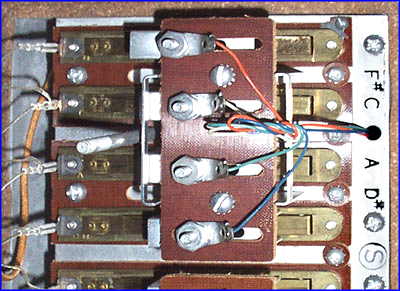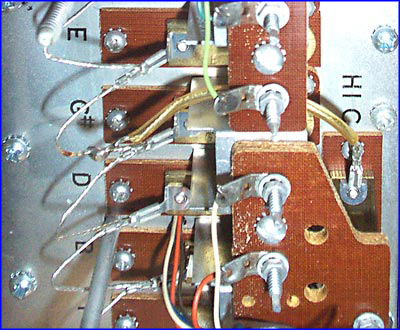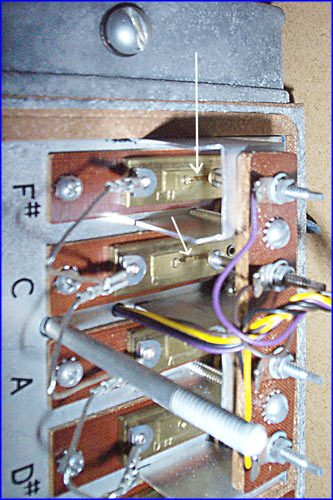Wurlitzer 4600 series
North Suburban Hammond Organ Service
As we continue looking through the Wurlitzer 4600 series instruments reed unit, here we see both the first octave of bass reeds that generate the 16' octave of pedal tones, and we also see the top octave. This system over-all gives surprisingly good sounding bass which has plenty of fundamental and also a few of the lower order harmonics to add definition. Notice that on these reeds the pickups are in slots in the bakelite strips so that in addition to adjusting them closer or farther from the reeds, you can also change their relative position, closer to the center for more fundamental, or closer to the front end for slightly more harmonic development.

Figure 11.
In looking at two of these instruments, one a 4600 that was designed for pops playing, and the other a 4602 which is the 32 pedal classical version, it appears that the reed pickupsfor the pedals in the 4600 are closer to the center to give a bass tone with slightly less harmonic content. This would be a little more like the 16' tibia bass in a theater pipe organ whereas putting the pickups closer to the front would give a bass tone a little like the 16' wood diapason of a larger classical pipe organ. Essentially the 4600 and the 4602 are very similar, but there are slight differences. Both have the same basic sound and the same tone generation system.
The vibrato on the 4600 is more pronounced on the "full" setting, and although the voices are the same, the names on the stop tabs are different. But then, as with so many things, you can (within reason) give different names to identical things. This seems to be especially true when it comes to the naming of sounds on organ stops.
Here [Figs eleven and twelve] are two views of the first or sub octave of reeds which provide notes 1-12 when using the 16' pedal stop. These reeds have only a single pickup and notice that the pickups are set close to the centers of the reeds. This produces a tone which is mostly fundamental with relatively small amounts of the second, third, fourth and fifth harmonics. The resulting tone is reasonably suggestive of a 16' tibia on a theater pipe organ, however the second harmonic on the electronically generated tones is somewhat evident whereas there is almost no second harmonic at all in a pipe organ tibia rank.
Figure 12, Below.

Next, we take a look at the very top octave of reeds. Notice at the right that there is an extra reed for top C. All of the rest of the reed pans have 12 reeds in each one, but the the top octave has thirteen in order to have a pitch available for top C. Refer to figure thirteen.

Figure 13.
This is actually a far more important point than you might think at first. I have played some instruments where, maybe for reasons of economy, there is no top C. You really do notice it. To me, leaving out top C is a big mistake. Usually, however, it seems that this omission occurs on instruments where engineers have had too much input on the final design. You need engineers to design the basic instrument and the circuitry to make it work, but it is first and foremost a musical instrument, and any electronic instrument where the engineer has had more influence than the musician is usually doomed to ultimate failure as a musical instrument. Sorry, engineers! But it just seems to work out that way. Maybe you guys should learn how to play something!

Figure 14.
Here's another close look at the top octave of reeds. The white arrows point to two of the actual reeds. Notice that these tiny reeds [indicated by white arrows] are so small that the actual reed strip is narrower than the slots in the screws that you see here. There is only one pickup because these reeds only need to produce flute tone.
Previous Page Page 9. Next page